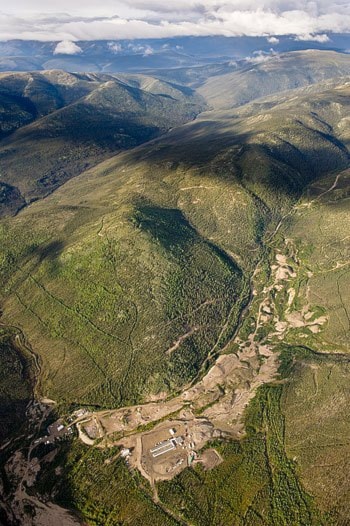Victoria Gold Corp. is pushing ahead with plans to build an open-pit gold mine near Mayo by 2014.
The Eagle deposit, which sits on its Dublin Gulch property, has probable reserves of 1.7 million ounces of gold and indicated resources of 4.8 million ounces of gold.
That’s enough shiny metal to keep miners busy for a decade, although the company hopes to expand its resources so the operation runs far longer than that.
The proposed mine would have 200 workers on site at any time. The total workforce would be nearly double that size.
The company expects between 10 to 20 per cent of the workforce to be from Mayo, with the rest flown in from Whitehorse or Outside.
At present, there are 75 workers and three drills on site, where an all-weather camp was built last autumn. The company is spending $9 million this year to prove up Eagle’s reserves and explore the nearby Potato Hills trend.
The company submitted its mine proposal to regulators in December. The Yukon Environmental and Socioeconomic Assessment Board is accepting public comments on the project until the end of the month.
So far, the project has managed to avoid any major criticisms.
The Department of Fisheries and Oceans has urged the company to take precautions in snow-clearing activities, construction of a transmission line and other work that may harm fish in nearby waterways.
And Environment Canada wants to ensure the mine carefully monitors its discharged water for residue of nasty chemicals. With radioactive rocks present in the area, that could include radium and uranium.
But none of these concerns appear to be dealbreakers. And nobody has expressed outright opposition to the project.
“I think one reason why you haven’t seen negative comments is because we actually know what we’re doing,” said John McConnell, Victoria Gold’s president and CEO. He points to his own experience in operating mines in the Northwest Territories, and the many old hands on Victoria Gold’s board of directors.
McConnell knows that First Nations support can make or break a mining project in the Yukon. So he’s taken pains to win over the Na-Cho Nyak Dun.
“We understand it’s their land. That’s the approach we take,” he said. “We want them to be our partners, not our adversaries.”
Victoria Gold has struck a deal with the First Nation to ensure its members are represented at the exploration camp. A similar deal is planned for the mine’s operation.
The mine would use cyanide to separate gold from ore, using what’s called a heap leach. Western Copper Corporation’s plans to heap leach its copper deposit near Carmacks faced heavy public opposition, for fear a spill would pollute the nearby Yukon River.
But there are big differences between heap leaching for copper and gold, said McConnell. Copper heap leaches uses sulphuric acid. There are few examples of such mines operating in northern climates.
Gold heap leaches use cyanide. While poisonous, it’s relatively easy to break down, said McConnell. And the technology is tried and true.
“I’d say there’s probably 10,000 cyanide heap leach operations around the world,” said McConnell.
The Yukon’s Brewery Creek mine ran a gold heap leach. So does Kinross’ Fort Knox Mine in Alaska, where the company has taken Mayo residents and regulators on tours, so they better understand what’s proposed.
Western Copper’s plans would have seen massive mounds of ore drenched with acid. Fort Knox’s operation is less dramatic to view - arsenic is trickled through swaths of ore with an underground drip feeder, similar to field irrigation.
“One regulator said, ‘Where’s the heap leach?’” said McConnell. “I said, ‘You’re standing on it.’”
Victoria Gold hopes to clear enough regulatory hurdles to begin building the mine by this time next year. But it remains to be seen whether they’ll be the ones who own the property by then.
Typically, mining juniors with viable properties are gobbled up by major gold producers, which possess the expertise in running mines, and the deep pockets to build them.
“That could happen,” said McConnell. But he said the company is also sussing out whether banks would finance the mine, which is expected to cost $300 million to build.
Or Victoria Gold could strike a partnership with a bigger partner. The Yukon’s seen the Chinese help underwrite several big projects, but McConnell doesn’t expect this to be the case with the Eagle mine.
China’s hungry for base metals to help fuel their construction boom. “I’m not sure China’s interested in gold,” he said.
A more likely partner, or buyer, may be Kinross. Besides being one of Canada’s biggest gold producers, it is also Victoria Gold’s biggest shareholder, owning nearly one-fifth of the company’s stock.
Contact John Thompson at
johnt@yukon-news.com.
